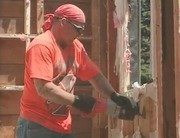OK, well we're in the master bathroom now.
And a lot of the detailing in here has been completed by our homeowner who's doing the mill work himself and he's put up shelves as you can see behind me.
And nice paneling under the window opening.
And the bathroom.
One of the great things is it's got double windows in here.
These are Pella's architectural line that they chose, which is a nice historic look, it's very appropriate for this 1890's house.
And what you've got here is two lights over one.
Which is a style of window that was very popular back then, but it's high tech in that we have low emissivity glass with argon gas in between the two sheets of glass and we have got essentially Energy Star rating on the windows.
They were all installed last week, but right now we want to say hi to Grant Garcia and Chris Dada who are here to here to install a Corian Tub surround.
Hi Bob.
Hi guys.
So, this is always an interesting thing because this is not fabricated.
Did it on the job right?
That's correct.
It's taken and then you've gotta do templates and stuff and do it in your shop and then bring it to, to the house side.
That's correct.
Now what kind of bead is this caulking?
Well, Chris is applying a high quality silicone that has mildew resistance integrated into it.
OK.
And that eventually is going to seep out and form the seam between the soaking tub and the deck.
So the tub is our cast iron, enameled finis , and this is our corian, and this will be in between the two.
Tell us about corian.
What's one of the advantages of using it in this kind of situation?
Well, it's non-porous, it's renewable.
It is not going to support the growth of bacteria or mold, which in a wet area like a bathroom is absolutely essential.
For sure.
And it is fabricated custom, right?
That's correct.
We come in ahead of time and make a template.
Now this, this tub over here is an unusual situation, in that it's kind of an over mount and its been laid down on the frame.
But then we're treating it as an under mount by putting this over it, right?
Exactly, that's right.
We're using it in a little different way.
We're using it just as an under-mount, just like you would a sink on your... a stainless steel still sink under a tub.
OK.
So your ready to go here.
Can I give you a hand putting it in there?
Oh yes sure.
Sure.
Catty corner.
You're in.
Yeah.
I got it.
Let's bring it up.
It's the other way Chris.
Like that.
There you go.
Front in first.
And when we say custom made, it's even got a little dog ear here to go around the trim.
Now, how do you go about making a template to have this cut back at the shop?
Well, because of the unusual shape of the tub, and also the space itself, what we try to do is get an exact digital template made.
Digital photo templating allows us to put the markers where we will around the wall and also around the object itself.
So, you' ve come in here physically and taken a whole bunch of photographs of the tub.
Twenty-four to be exact.
With a digital camera.
Correct.
And then what happens to those photographs.
Well, in the photographs you have the object dots, as you can see.
And then you also have the coordinate dots, which are on those panels in the middle of the tub.
Right.
Well, the software knows how to read all those.
And is able, through photogrammetry, is able to create what you might call a a panorama shot of the whole object.
And then it's able to give us precise locations of all these dots.
So that the fabricator can actually get a paper template from that to transfer onto the Corian.
Well, we actually do one better, even.
Before the fabricator gets it, we connect all those dots.
Dot to dot.
Create a CAD drawing that a CNC router actually cuts out all the parts of, out of the sheet.
Yeah.
And so, when the fabricator receives it, it's sort of like a model airplane kit that he puts together.
Alright, so there is a lot of behind the scenes work.
And we all love the instant gratification of just setting it down and seeing it as the finished product.
Tell me about some of the features here.
Because I'm looking at this edge, which I don't recognize.
Well, what you see here is a tile cove.
The ceramic tile that Nick and Maggie have chosen is going to right down on this tile cove .
In fact, here is an example of it.
So, what is happening there is, it's going to make it a very easy to clean surface.
You'll never have have any water or any dark lines appearing there, because water and dirt have gotten in there, and of course you can see with the tile you're holding, Bob, how it matches with the Storm Blue Corian —
Yeah.
— one of the hundred and twenty colors available in the line.
Yeah, they've chosen a mixture of this glass tile with the white subway tile.
And it's a very, very nice combination.
Alright.
And cement board which is, again, a half-inch thick is the best product to use as a substrate for ceramic tile or marble because of its resistance to moisture.
Exactly.
And we're just driving screws in it and fastening it to the studs.
Now, Grant, the cement board is terrific for the tile, but there's always the issue of moisture getting in down at the joint between the tub or the tub deck and the vertical surface.
And when that happens repeatedly you got health issues with mold growth etcetera.
Correct.
And you've got the potential for rotting lumber.
Because you have moisture that can get in behind.
So what kind of a detail we are going to have here in terms of the transition?
Well when that moisture does intrude, if it should, it would probably wick up behind the tile which is sitting on the tile cove.
And if there was some kind of sheet rock or other material there like the green board, moisture resistant board it would actually act as a wick and it would start wicking that moisture right up the wall.
And right into the gypsum if it is a gypsum board and that gets mushy and gets destroyed in a few years.
And moldy
Yeah.
And a number of other things.
So, what we do to eliminate that is first of all we have the secondary line of defense against moisture intrusion and that's this water dam right here.
This is also made out of Corian, fabricated integrally into the tub deck.
And then there's an air space AC is here, it's about half inch three quarter, maybe an inch and the tile will actually span that so you so you will never see
it.
OK. Now in terms of dealing with the caulking that you've got in there, which is a silicone product.
A lot of people hate working with the silicon if you do not do exactly right it would not look very, very good.
Any tips on how to get a good even application?
Yes, we allow the silicon to seep out from underneath the tub deck.
The bead that you put down earlier, before you set the deck down?
Exactly, yes.
Then what Chris did is he came back with denatured alcohol and sprayed the entire area around the bead before he tooled it at all.
And now, while his hands are protected, he is tooling it with a little piece of laminate.
Any kind of square, stiff material that you can use as a tool or I guess you could use a putty knife.
A knife would be good, except it might scratch the ceramic.
Yeah.
So, by not touching it with human hands at all you, you avoid the risk of dirt getting in there or bacteria that might later on grow in some way.
Great.
Well, that is gonna be a very neat job.
I can't wait see all he tile finished.
And, of course, you guys here in Massachusetts, it's Sterling, is
it? You do all of these installations.
Right?
Yes.
Tile, marble, Corian and whatever?
We do kitchens, baths, and we specialize in Corian.
Thanks a lot, Grant.
Thank you very much, Bob.
Okay.





